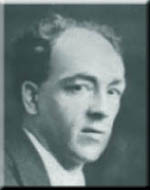
James Stephens
Born 8th Feb 1882  Died 26th
Dec 1950
Died 26th
Dec 1950
Irish Poet and writer James Stephens was born in Dublin in either 1880 or 1882. At the age of two James' father passed away leaving his mother to fend for herself in the Dublin slums. His mother remarried or took up with another man when James was about six years of age. She abandoned her young son and he was forced to go to the Meath Protestant Industrial School for Boys. Even though his life experience at the Meath School was cruel and harsh he seem to not have held any ill-will towards his mother as it did not show up in his writings. Stephens ran away from the Meath School living on the streets and with several families willing to take him into their homes.
Stephens’s first story “The Greatest Miracle” was published by Arthur Griffith in The United Irishman on 16 September 1905. Griffith became good friends with Stephens and published his works in his magazine know as the Sinn Fein. From 1905-1910, Stephens attended Gaelic League classes and become involved with political meetings. During this time he published several pieces which focused on Irish national pride, the importance of learning one's Irish language and customs, and remembering the ancient saga heroes. Stephens met many of his great contemporaries during this period including George Russell (AE), George Moore, W.B. Yeats, Lady Gregory, etc.
In the year 1912, Stephens published "The Charwoman’s Daughter" and later in the same year his noted work "The Crock of Gold". "The Crock of Gold" was a great success and Stephens moved to Paris so he could concentrate on writing full time. Cynthia Kavanagh who had been his lover since 1907 accompanied him. He later married her in 1919. "The Demi-Gods" was published in 1914 and in 1915 he moved back to Dublin to become the Registrar of the National Gallery of Ireland and stayed in that position till 1924.
Stephens witnessed the shooting of a man as a result of the Easter Uprising in Dublin in 1916. This became a turning point for him as he wrote the elegy, "Green Granches" (1916), and "The Insurrection in Dubin" (1016). The event intensified his patriotic feelings and renewed his interest in old Irish literature. His collection of poems, "Reincarnations" was published in 1918. He then wrote three books, "Irish Fairy Tales" (1920), "Deirdre" (1923), and "In the Land of Youth" (1924). "Deirdre" and "In the Land of Youth" were intended to be part of a five volume version of Tain. He never wrote the last three volumes due to his failing physical and mental health.
Stephens moved to London in the year 1925. He began a series of lecture tours which extended to the United States. In 1935 Stephens began a literary and personal friendship with James Joyce. "Etched in Moonlight" a collection of short stories was published in 1928. "How Saint Patrick Saves the Irish" came shortly after. During the 1930’s Stephens wrote poetry influenced by his studies of Eastern literature and philosophy. These offerings were "Strict Joy" (1930), and "Kings and the Moon" (1938). Stephens’s moods and depression became very evident in his final volumes. He rebounded in 1937 doing lecturing about poets and poetry on the BBC. He continued that work until his death in 1950.
His colleagues considered Stephens to be a genius and Frank O'Connor referred to him as a man with a most agile mind. These characteristics were shown through his writing as he was able to bounce the emotions of characters and subject with ease. He was a writer of many talents, including novels, short stories and poetry. He embraced fantasy, philosophy, and comedy. His characters came from all walks of life and every emotion ranging from love, betrayal, intrigue and heroism. He merged all his literary works to reveal the true life of the Irish. He is remembered by the Irish as he portrayed their love for their customs, language, and their hositilies towards repression. Stephens work never hinted at imitation of the poets of this period for he was uniquely his own person.